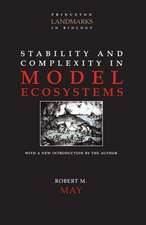Dynamic Modeling in Behavioral Ecology: Monographs in Behavior and Ecology
Autor Marc Mangel, Colin Whitcomb Clarken Limba Engleză Paperback – 30 iun 1992
The authors show how to construct and use dynamic behavioral models. Part I covers the mathematical background and computer programming, and then uses a paradigm of foraging under risk of predation to exemplify the general modeling technique. Part II consists of five "applied" chapters illustrating the scope of the dynamic modeling approach. They treat hunting behavior in lions, reproduction in insects, migrations of aquatic organisms, clutch size and parental care in birds, and movement of spiders and raptors. Advanced topics, including the study of dynamic evolutionarily stable strategies, are discussed in Part III.
Din seria Monographs in Behavior and Ecology
-
 Preț: 301.76 lei
Preț: 301.76 lei - 19%
 Preț: 653.16 lei
Preț: 653.16 lei - 19%
 Preț: 601.08 lei
Preț: 601.08 lei - 19%
 Preț: 593.80 lei
Preț: 593.80 lei - 19%
 Preț: 652.68 lei
Preț: 652.68 lei - 19%
 Preț: 646.47 lei
Preț: 646.47 lei - 19%
 Preț: 613.33 lei
Preț: 613.33 lei - 19%
 Preț: 563.86 lei
Preț: 563.86 lei - 19%
 Preț: 616.91 lei
Preț: 616.91 lei - 19%
 Preț: 607.69 lei
Preț: 607.69 lei - 19%
 Preț: 524.50 lei
Preț: 524.50 lei - 19%
 Preț: 517.80 lei
Preț: 517.80 lei - 19%
 Preț: 520.88 lei
Preț: 520.88 lei - 19%
 Preț: 519.96 lei
Preț: 519.96 lei - 19%
 Preț: 646.91 lei
Preț: 646.91 lei - 19%
 Preț: 518.11 lei
Preț: 518.11 lei - 19%
 Preț: 518.56 lei
Preț: 518.56 lei - 19%
 Preț: 548.91 lei
Preț: 548.91 lei - 19%
 Preț: 649.87 lei
Preț: 649.87 lei - 19%
 Preț: 486.48 lei
Preț: 486.48 lei - 19%
 Preț: 673.26 lei
Preț: 673.26 lei - 23%
 Preț: 859.11 lei
Preț: 859.11 lei - 23%
 Preț: 864.43 lei
Preț: 864.43 lei - 19%
 Preț: 423.43 lei
Preț: 423.43 lei -
 Preț: 420.61 lei
Preț: 420.61 lei
Preț: 490.96 lei
Preț vechi: 606.12 lei
-19% Nou
Puncte Express: 736
Preț estimativ în valută:
93.95€ • 102.46$ • 79.22£
93.95€ • 102.46$ • 79.22£
Carte tipărită la comandă
Livrare economică 24 aprilie-08 mai
Preluare comenzi: 021 569.72.76
Specificații
ISBN-13: 9780691085067
ISBN-10: 0691085064
Pagini: 320
Ilustrații: 1
Dimensiuni: 151 x 229 x 19 mm
Greutate: 0.45 kg
Editura: Princeton University Press
Seria Monographs in Behavior and Ecology
Locul publicării:Princeton, United States
ISBN-10: 0691085064
Pagini: 320
Ilustrații: 1
Dimensiuni: 151 x 229 x 19 mm
Greutate: 0.45 kg
Editura: Princeton University Press
Seria Monographs in Behavior and Ecology
Locul publicării:Princeton, United States
Descriere
Describes a flexible technique for the modeling of behavior, based on evolutionary principles. The technique employs stochastic dynamic programming and permits the analysis of behavioral adaptations wherein organisms respond to changes in their environment and physiological state. This book shows how to construct and use dynamic behavioral models.















